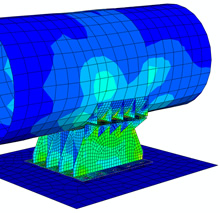Stress simulations for all kind of industries

Providing services for both civil and military industries by investigating structure’s response and stress distribution occuring static loads
Strength Analyses
Strength analyses can be applied to entire structure or a part of structure that characterizes the whole structure or a local part of a structure that is required to be investigated. Analyses for entire structure are definitely the most reliable type in perspective of boundary conditions. However, due to the computer resources restrictions, the time spent for modeling and the analysis step limitations, analyzing a part of structure that characterize the whole structure or a required local part of the structure, is the most generally applied method.
Video Archive
The purpose of the strength analyses is to investigate the structure's response and the stress distribution that will occur against internal or external static loads with boundary conditions by finite element mesh distribution which best represents the reality.
According to structure type, beam elements, shell elements and solid elements can be used in strength analyses.
Although the fundamental principals are the same, offshore and land structures differ in perspective of variety of analyses and loads. Both offshore and onshore structure analyses are in field of our interest and we provide services for both civil and military purposed branches of industry such as;
Land Structures
- Iron Concrete or Steel Buildings
- Bridges
- Industrial Facilities
- Pressure Vessels
- Machinery and Machinery Parts
- Vehicles and Vehicle Parts
Offshore Structures
- Ships
- Platforms
- Barges
- Floating Docks
- Floating Cranes
Visual Archive
Strength Analyses for Ship Structures
Ship structural analyses that have special rules for finite element methods can be separated in perspective of ship type and required type of analysis as specified below. Results of these analyses are evaluated according to the related classification society rules.
Global Ship Strength Analysis
Ship is entirely modeled. Still water and wave induced bending moments and torsion moments are applied to the ship model and the response is investigated.
Differentiated Method for Strength Analysis
Two or three following ship compartments which are placed at amidship and characterize the ship beam are differentiated from global model. This ship beam pattern can be analyzed by appropriate boundary conditions and loading cases. Three-compartment finite element model can be used in large ships where the bending moments are dominant and globally loading can be applied to model's boundaries. Two-compartment finite element model can be used in small ships where the bending moments are not dominant and globally effects can be added separately.
Local Strength Analysis
Local stress concentrations on the local structures such as crane foundations, masts, engine foundations and connection supports are investigated and necessary modifications are determined.
